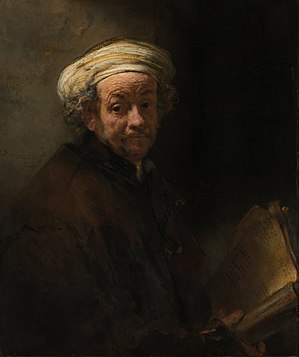
Dirck Jaspersz. van Baburen was a Dutch painter and one of the Utrecht Caravaggisti.
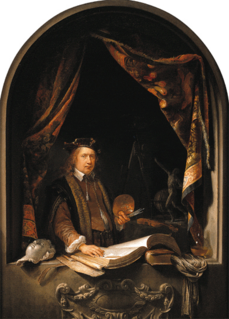
Gerrit Dou, also known as GerardDouw or Dow, was a Dutch Golden Age painter, whose small, highly polished paintings are typical of the Leiden fijnschilders. He specialised in genre scenes and is noted for his trompe-l'œil "niche" paintings and candlelit night-scenes with strong chiaroscuro. He was a student of Rembrandt.

Portrait of Baldassare Castiglione is a c. 1514–1515 oil painting attributed to the Italian High Renaissance painter Raphael. Considered one of the great portraits of the Renaissance, it has an enduring influence. It depicts Raphael's friend, the diplomat and humanist Baldassare Castiglione, who is considered a quintessential example of the High Renaissance gentleman.

Jan Lievens was a Dutch Golden Age painter who was associated with his close contemporary Rembrandt, a year older, in the early parts of their careers. They shared a birthplace in Leiden, training with Pieter Lastman in Amsterdam, where they shared a studio for about five years until 1631. Like Rembrandt he painted both portraits and history paintings, but unlike him Lievens' career took him away from Amsterdam to London, Antwerp, The Hague and Berlin.

Dutch Golden Age painting is the painting of the Dutch Golden Age, a period in Dutch history roughly spanning the 17th century, during and after the later part of the Eighty Years' War (1568–1648) for Dutch independence.

Rembrandt Harmenszoon van Rijn, usually simply known as Rembrandt, was a Dutch Golden Age painter, printmaker and draughtsman. An innovative and prolific master in three media, he is generally considered one of the greatest visual artists in the history of art and the most important in Dutch art history. Unlike most Dutch masters of the 17th century, Rembrandt's works depict a wide range of style and subject matter, from portraits and self-portraits to landscapes, genre scenes, allegorical and historical scenes, and biblical and mythological themes as well as animal studies. His contributions to art came in a period of great wealth and cultural achievement that historians call the Dutch Golden Age, when Dutch art, although in many ways antithetical to the Baroque style that dominated Europe, was extremely prolific and innovative and gave rise to important new genres. Like many artists of the Dutch Golden Age, such as Jan Vermeer of Delft, Rembrandt was also an avid art collector and dealer.

Aert de Gelder was a Dutch painter.

Hendrik Martenszoon Sorgh was a Dutch Golden Age painter of genre works.
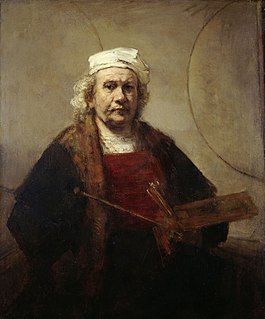
A self-portrait is a representation of an artist that is drawn, painted, photographed, or sculpted by that artist. Although self-portraits have been made since the earliest times, it is not until the Early Renaissance in the mid-15th century that artists can be frequently identified depicting themselves as either the main subject, or as important characters in their work. With better and cheaper mirrors, and the advent of the panel portrait, many painters, sculptors and printmakers tried some form of self-portraiture. Portrait of a Man in a Turban by Jan van Eyck of 1433 may well be the earliest known panel self-portrait. He painted a separate portrait of his wife, and he belonged to the social group that had begun to commission portraits, already more common among wealthy Netherlanders than south of the Alps. The genre is venerable, but not until the Renaissance, with increased wealth and interest in the individual as a subject, did it become truly popular.

The Prodigal Son in the Brothel or The Prodigal Son in the Tavern or Rembrandt and Saskia in the parable of the prodigal son is a painting by the Dutch master Rembrandt. It is housed in the Gemäldegalerie Alte Meister of Dresden, Germany. It is signed "REMBRANDT F.".

Self Portrait is an oil on canvas painting by the Dutch artist Rembrandt. Painted in 1652, it is one of over 40 painted self-portraits by Rembrandt, and was the first he had painted since 1645. In composition it is different from his previous self-portraits, depicting the painter in a direct frontal pose, hands on his hips, and with an air of self-confidence. It was painted the year that his financial difficulties began, and breaks with the sumptuous finery he had worn in previous self-portraits. Art historian Christopher White has called it "one of the most magisterial and sombre of these (late) pictures". It is in the Kunsthistorisches Museum in Vienna.

Self-Portrait with Two Circles is an oil on canvas painting by the Dutch artist Rembrandt, painted c. 1665–1669, one of over 40 painted self-portraits by Rembrandt.

Self-Portrait with Beret and Turned-Up Collar is a 1659 oil on canvas painting by the Dutch artist Rembrandt, one of over 40 self-portraits by Rembrandt. It has been noted as a self-portrayal of subtle and somber qualities, a work in which may be seen "the stresses and strains of a life compounded of creative triumphs and personal and financial reverses". Once owned by Andrew W. Mellon, it has been in the National Gallery of Art since 1937.
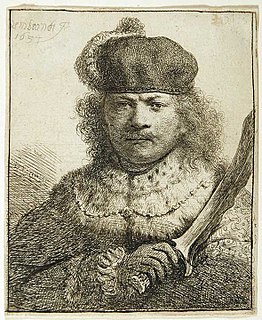
The dozens of self-portraits by Rembrandt were an important part of his oeuvre. Rembrandt created approaching one hundred self-portraits including over forty paintings, thirty-one etchings and about seven drawings; some remain uncertain as to the identity of either the subject or the artist, or the definition of a portrait.

This 1629 self-portrait by Dutch painter Rembrandt van Rijn is part of the Clowes Fund Collection of the Indianapolis Museum of Art in Indianapolis, Indiana. It is among the earliest of over 40 self-portraits by Rembrandt, which he produced over the course of four decades.
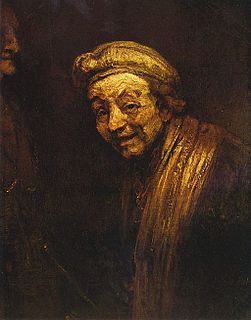
Self-portrait as Zeuxis Laughing is one of over 40 painted self-portraits by Rembrandt. Painted around 1662 by the Dutch artist Rembrandt, it is now in the Wallraf-Richartz-Museum in Cologne.

Self-Portrait at the Age of 63 is a self-portrait by the Dutch artist Rembrandt. One of three dating to 1669, it was one of the last in his series of around 80 self-portraits, painted in the months before his death in October 1669. Despite the closeness of his death, and the concentration on his aging face, Rembrandt makes an impression of a self-assured and confident artist. It was bought by the National Gallery, London in 1851.
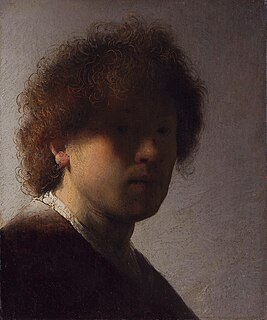
Self-portrait with dishevelled hair, Self portrait as a Young Man, and various other titles, is an early self-portrait by the Dutch artist Rembrandt, now in the Rijksmuseum. It dates to 1628 and is an exercise in chiaroscuro. It is one of the earliest of over 40 painted self-portraits by Rembrandt.
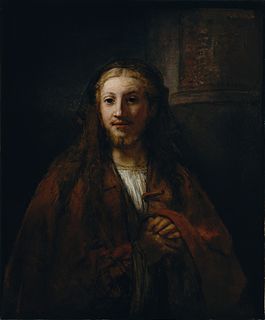
Christ with a Staff or St James the Less is a 1631 painting by Rembrandt, now in the Metropolitan Museum of Art. It was also known as Christ in 1854 and exhibited in 1933 as The Pilgrim.

Rembrandt Laughing is a c. 1628 oil on copper painting by the Dutch painter Rembrandt van Rijn. It is an elaborate study of a laughing face, a tronie, and, since it represents the painter himself, one of over 40 self-portraits by Rembrandt, probably the earliest elaborate one. The painting, which was only recently discovered, is now in the J. Paul Getty Museum, California.
